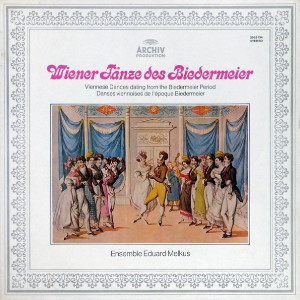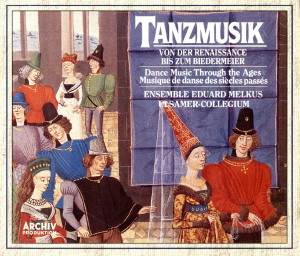 |
|
1 LP -
2533 134 - (p) 1973
|
 |
| 4 CD's -
439 964-2 - (c) 1992 |
|
| WIENER TÄNZE DES
BIEDERMEIER |
|
|
|
|
|
|
|
| Viennese Dance dating from
the Biedermeier Period |
|
|
|
|
|
|
|
| Michael Pamer
(1782-1827) |
Walzer in E-dur (1818) |
Ersdruck (1818).
Cappi & Diabelli, Wien.
Expl. Stadtbibliothek Wien |
|
4' 00" |
A1 |
| Ludwig van
Beethoven (1770-1827) |
Tämze
"Mödlinger Tänze", Nr. 1-8,
WoO 17 (1819) |
Erstausgabe
(1907). Breitkopf & Härtel,
Leipzig. Ed. H. Riemann
(Part.-Bibl. 2058) |
|
13' 57" |
A2 |
| Ignaz
Moscheles (1794-1870) |
Deutsche Tänze
samt Trios und Coda (1812) |
Ms. Wien,
Österreichische
Nationalbibliothek, Sm 2240 |
|
8' 21" |
A3 |
| Franz Schubert
(1797-1828) |
5 Menuette mit
6 Trios, D. 89 (1813) |
Schubert-GA,
Serie II, Nr. 8 |
|
13' 30" |
B1 |
| Franz Schubert |
4 komische
Ländler, D. 354 (1816) |
Schubert-GA,
Supplement |
|
2' 13" |
B2 |
| Anonym |
Linzer Tanz.
Wiener Polka (um 1820) |
Universal
Edition Wien. "Rote Reihe", Bd.
3 (UE 20 003). Ed. W. Deutsch |
|
3' 32" |
B3 |
| Joseph Lanner
(1801-1843) |
Ungarischer
Galopp in F-dur (um 1835) |
Ms. Wien,
Stadtbibliothek, MH 2255 |
|
2' 19" |
B4 |
|
|
|
|
| ENSEMBLE
EDUARD MELKUS |
| -
Eduard Melkus, Spiros Rantos, Solovioline |
| -
Thomas Kakuska, Günther Schich, M.
Gomberti, Wilhelm Jordan, Reinhart
Strauß, E. Eichwalder, Prunella
Pacey, Lilo Gabriel, Violine |
| -
Lilo Gabriel, Viola |
| -
Martin Sieghart, Violoncello |
| -
Heinrich Schneikart, Kontrabaß |
| -
Karl Scheit, Gitarre |
| -
Werner Tripp, Barbara Müller-Haase,
Flöte |
| -
Manfred Kautzky, Günter Lorenz, Oboe |
| -
Alfred Prinz, Peter Schmidl, Horst
Hajek, Klarinette |
| -
Dietmar Zeman, Camillo Öhlberger, Fagott |
| -
Friedrich Gabler, Gernot Sonneck, Horn |
| -
Josef Hell, Josef Pomberger, Wilhelm
Kormann, Trompete |
| -
Josef Rohm, Posaune |
| -
Richard Hochrainer, Georg Wagner, Schlagwerk |
|
|
|
|
Luogo
e data di registrazione |
|
Palais
Schönburg, Vienna (Austria) -
10/12 aprile 1972 |
|
|
Registrazione:
live / studio |
|
studio |
|
|
Production |
|
Dr.
Andreas Holschneider |
|
|
Recording
supervision |
|
Werner
Mayer
|
|
|
Recording Engineer |
|
Klaus
Scheibe |
|
|
Prima Edizione LP |
|
ARCHIV
- 2533 134 - (1 LP - durata 48'
15") - (p) 1973 - Analogico |
|
|
Prima Edizione CD |
|
ARCHIV
- 439 964-2 - (4 CD's - durata 71'
35"; 70' 09"; 70' 42" & 72'
56" - [CD4 5-11]) - (c) 1992 - ADD
|
|
|
Cover |
|
Wiener
Biedermeier-Szenen: "Tanzmeister
Pauxel" oder "Faschingsstreiche".
Theatermuseum München |
|
|
Note |
|
-
|
|
|
|
|
Viennese Dance
dating from the Biedermeier
Period
“In Vienna in July there is a
real folk festival, if ever a
festival deserved the name. It
is given by and for the ordinary
people, and if anyone of higher
rank happens to join in, then
only in his role as a normal
citizen. This is the day when
the people of Brigittenau hold
their parish fair. In the
usually peaceful town uproar
prevails. Class distinctions
vanish; worthy citizens and
rough soldiers share in the
bustle... Those who come by
carriage climb down and mingle
with their brethren on foot; the
strains of distant dance-music
float overhead and are taken up
by cheering newcomers. And so
on, further and further, until
this generous harbour of
delights opens out, and woods
and meadows, music and dance,
wine and feasting, shadow-plays
and tightrope walkers, bright
lights and fireworks all blend
to become a true Eldorado, a
real piece of Paradise...” There
is no better picture of the
Viennese spirit during the
Biedermeier period than this
sketch by the Austrian novelist
Franz Grillparzer, taken from
his short story, Der arme
Spielmann.
In Austria Biedermeier
was that clearly defined period
between the Congress of Vienna
in 1815 and the year of the
Revolution, 1848, between the
end of the Napoleonic era and
the first attempts by the
bourgeoisie to wrest away some
of the privileges of the
all-powerful aristocracy. At
that time the old imperial city
of Vienna was still surrounded
by mighty fortifications beyond
which there were villages and
little towns in the midst of
pastureland and vineyards.
Vienna was still the musical
metropolis of the world, and
there was music everywhere - in
the theatre, in the churches, in
stately palaces, middle-class
homes and village taverns. In
all this, dance music was by no
means the worst off; it was not
considered in the least lowly,
and it was treated with respect
by the great masters as well as
by dozens of less famous
composers whose names have now
been forgotten.
In such an atmosphere it was
only natural that Franz Schubert
- one of the few great Viennese
composers who were actually born
in Vienna - played waltzes and
ländler on the piano, and that
he wrote them down. It was also
only natural that for his own
friends he composed minuets
scored for a string quartet; it
was customary at the time to
write them for a large orchestra
to be played in the ballroom.
The fact that they are
masterpieces is just another
extraordinary aspect of this
young man’s genius - at the time
he was just 16. The moods of the
late string quartets are already
evident here, and the formal
interweaving of minuets and
trios is a stroke of genius.
Minuets I, III and V each have
two trios, Minuets II and IV on
the other hand none at all; the
result is that when played in
sequence Minuets III and V seem
to become trios for the minuets
that precede them. By erasing
the contours of his
compositions, Schubert achieves
a remarkable effect of
concentration.
As he wandered with his friends
through the villages, Schubert
was constantly absorbing the
stock-in-trade of the local
music. A favourite setting was
for two violins and a small
double bass - the so-called
“Bassl”; occasionally the tonal
gap between these was filled up
by a guitar, and sometimes the
guitar took the bass’s place.
The “violinists from Linz” came
down the Danube to Vienna with
these instruments, and played
for dances there. In the
versions which have survived,
one can often still find the old
pairing of slow and fast dances
(as in the “Linz” dance). The
polka imported from Bohemia also
puts in an appearance, though
here in a Viennese version
(Viennese Polka). And when the
young Schubert writes four
“comic ländler” for two violins
he makes a good job of imitating
the manner of popular
music-makers.
Just as the nobility maintained
residences in the country for
the summer months, so the
wellheeled middle-classes liked
to have a house “in the
country”. The favourite
districts were just a few
kilometres from the city itself
in Heiligenstadt and Nussdorf;
Mödling and Baden were a day’s
journey away to the south. Those
without a country house would
rent rooms there and move out of
the city for the summer. The
great man from Bonn who had made
his home in Vienna also followed
this custom; during one of his
stays in Mödling, Beethoven
actually met the musicians for
whom he had written the
“Mödling” Dances in 1819.
Viennese folkmusic is often
scored for two clarinets as well
as two violins; in these dances
the clarinet dominates, though
the scoring also includes two
violins, a flute, a bassoon and
two horns. The idyllic mood is
strongly reminiscent of the Trio
from the Scherzo in the Eighth
Symphony.
One or two lesser composers also
achieved fame with some
brilliant compositions. The
music libraries in Vienna are
full of such works, and from
them we have chosen the German
Dances by Ignaz Moscheles. He
was born in Prague and was a
child prodigy as pianist and
composer. At the time of the
Congress of Vienna he was living
in the city, studying
composition under
Albrechtsberger and Salieri, and
appearing in his own concerts.
His German Dances exude the true
Schubertian spirit, and in their
tendency to modulate to the
minor and to make use of
third-relationships they show a
strong resemblance to Schubert’s
work. Right in the middle of the
turbulent coda there is, as a
finishing touch, a bell which
tolls twelve times (we find it
again as a charming touch in Die
Fledermaus) and the
nightwatchman’s song is invoked;
then the whole is rounded off in
a dashing finale.
A true product of the Viennese
outskirts was the tavern
violinist Michael Pamer, known
in his day as a great virtuoso.
He was active in teaching and
encouraging the younger
generation, to which Joseph
Lanner and Johann Strauss (the
Elder) belonged. Indeed it was
thanks to Pamer that the truly
“Viennese” waltzes became
accepted, and it was only on the
basis of his work that Joseph
Lanner, Vienna’s musical
darling, could produce his
gentle melodies which reveal the
very best aspects of Viennese
music of the time; even in the
guise of a Hungarian in the
Rakoczi March (The Hungarian
Galop) Lanner could not hide his
Viennese origins.
Looking back at this period over
one and a half tenturies, one
would like to enjoy its music in
its authentic form; it is
therefore reproduced here
without any retouching
whatsoever - markedly different
from the versions played by
modern dance bands, or those
“symphonic” effects produced by
our best orchestras. Here the
scoring is for a small group of
strings, the most usual way it
was heard then, and the original
instrumentation offers a natural
balance between strings and
wind.
E.
Melkus - W. Gabriel
|
|
|

